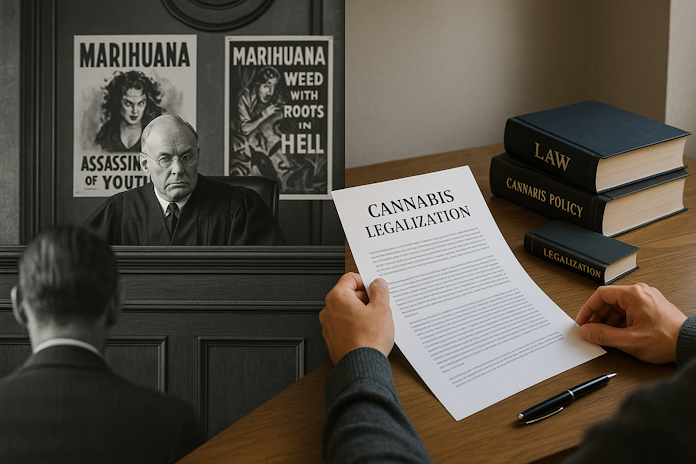
Herb
Understanding Why Is Marijuana Illegal: Historical and Legal Insights
Marijuana’s illegality isn’t just about the plant; it’s rooted in decades of politics, propaganda, and prejudice.
With so many states enacting recreational and medical cannabis laws, many individuals are wondering, “Why is marijuana illegal?” While the vast majority of states have established their own laws regarding cannabis use and possession, federal laws remain the same.
The federal prohibition of cannabis use and possession has led to the arrest of thousands for marijuana-related charges. According to the FBI, there were roughly 217,150 arrests for marijuana-related charges in 2023, and 84% of those were for possession only.
Why Was Marijuana Made Illegal In The First Place?

Cannabis sales were first restricted through the Marijuana Tax Act of 1937. The Marihuana Tax Act established an excise tax of $24 per year on importers, manufacturers, and compounders of marijuana, which translates to roughly $541 in today’s dollars.
Physicians, dentists, vets, or other practitioners who distributed cannabis products were charged an excise tax of $1 per year ($22). Individuals who dispensed cannabis products but were not physicians, dentists, vets, or other practitioners were charged $3 per year ($66). While the Marijuana Tax Act did not explicitly make cannabis illegal, it made it difficult to produce and dispense.
In 1944, the New York Academy of Medicine published a thorough report that concluded that marijuana use did not lead to violence, insanity, sex crimes, addiction, or other drug use. Alongside this report, during the 1940s, the U.S. government pushed farmers to grow hemp to produce various items for the military. In 1943, registered farmers grew 375,000 acres of hemp plants. So why is marijuana illegal?

WNYC Studios
Henry Anslinger. The first commissioner of the Federal Bureau of Narcotics (FBN), Henry J. Anslinger, and his friend William Randolph Hearst were key players in shaping marijuana policy. When Anslinger became the commissioner of the FBN, he further perpetuated stereotypes about cannabis users that were racist and not based in fact. He targeted Black Americans, Latinx Americans, Filipinos, and even entertainers like jazz musicians. Anslinger’s racism also helped popularize “marijuana” over “cannabis” when referring to the cannabis plant, furthering the anti-Mexican prejudice.
Together, Anslinger and Hearst used their power and platforms to slander marijuana and individuals who used it. Hearst continued to publish in his journals the harms of cannabis use and perpetuated “Reefer Madness.” In addition, individuals like Andrew Mellon and the DuPont Corporation supported the passage of the Marijuana Tax Act. Anslinger, Hearst, and Mellon also each contributed to the racist campaign against marijuana, primarily targeting Mexican immigrants and Black Americans.
With the passage of the Boggs and Narcotics Control Acts in the early 1950s, mandatory sentences were established for the possession of marijuana. In 1969, the Marijuana Tax Act was declared unconstitutional, and the Nixon administration formed the Shafer Commission to “establish the dangers of cannabis.” Against the advice of the Shafer Commission, which recommended decriminalization, President Richard Nixon passed the Controlled Substances Act (CSA) in 1970.
The Controlled Substances Act classified marijuana as a Schedule I drug, labeling it as having a high drug abuse potential and no accepted medical use. This formed a legal separation between two varieties of the same plant, Cannabis sativa. Any cannabis material or product with more than 0.3% THC was now considered illegal under the federal government.
Why Is Marijuana Still Illegal In So Many States?

Joey Csunyo / Unsplash
Federal prohibition of cannabis has continued for over 50 years, despite the overwhelming evidence supporting its medical use. Pharmaceutical companies have also formulated and profited from synthetic cannabinoids for the last half a century, with several FDA-approved drugs containing THC still being prescribed today.
Cannabis with more than 0.3% THC remains a Schedule I substance under the CSA. Being a Schedule I substance, getting funding for and researching cannabis has not been easy. However, in 2023, after push from the Biden Administration and various state elected officials, the Department of Health and Human Services (HHS) published a recommendation that cannabis be rescheduled to Schedule III. Making cannabis a Schedule III drug would make prescribing and researching cannabis much simpler.
As it stands, the use of non-FDA-approved cannabis products can only be recommended by physicians in legal medical marijuana states, not prescribed. However, making cannabis a Schedule III drug would not make it legal for individuals to use and possess without a proper pharmaceutical prescription. It is unclear how the rescheduling of cannabis could impact the current landscape of states where medical and recreational marijuana is legal.
Long story made short, marijuana is still illegal for recreational use due to the long history of cannabis prohibition and Drug War propaganda. Cannabis still faces significant hurdles, both in research and with federal laws on marijuana and state and local governments. While most U.S. states have legalized either medical or recreational marijuana, the stigma remains.
States Where Marijuana Is Legal for Medical Use

Elsa Olofsson / Unsplash
As of May 10th, 2025, 20 states currently allow for medical marijuana sales and usage, but have not passed any adult-use marijuana laws. Of those 20 states, seven only allow for CBD oil with limits on how much THC can be in each package, depending on the state. However, out of 20 states with medical marijuana laws, only six have decriminalized the possession and use of recreational marijuana.
- Alabama (Medical Only, Not Decriminalized)
- Arkansas (Medical Only, Not Decriminalized)
- Florida (Medical Only, Not Decriminalized)
- Georgia (Medical Only – No THC, Not Decriminalized)
- Hawaii (Medical Only, Decriminalized)
- Indiana (Medical Only – No THC, Not Decriminalized)
- Iowa (Medical Only – No THC, Not Decriminalized)
- Kentucky (Medical Only – No THC, Not Decriminalized)
- Louisiana (Medical Only, Decriminalized)
- Mississippi (Medical Only, Decriminalized)
- New Hampshire (Medical Only, Decriminalized)
- North Dakota (Medical Only, Decriminalized)
- Oklahoma (Medical Only, Not Decriminalized)
- Pennsylvania (Medical Only, Not Decriminalized)
- South Dakota (Medical Only, Not Decriminalized)
- Tennessee (Medical Only – No THC, Not Decriminalized)
- Texas (Medical Only – No THC, Not Decriminalized)
- Utah (Medical Only, Not Decriminalized)
- West Virginia (Medical Only, Decriminalized)
- Wisconsin (Medical Only – No THC, Not Decriminalized)
States Where Marijuana Is Illegal

jusdevoyage / Unsplash
The current list of states where marijuana is illegal, with no laws on the books for medical marijuana, is relatively short. At present, only five states have no established medical or adult-use marijuana laws, which include:
- Idaho
- Kansas
- North Carolina
- South Carolina
- Wyoming
States Where Marijuana Is Legal For Adult Use

Maria Moroz / Unsplash
As of May 10th, 2025, 23 states and D.C have legalized recreational marijuana for individuals 21 and over. States where marijuana is legal include:
- Alaska
- Arizona
- California
- Colorado
- Connecticut
- Delaware
- District of Columbia
- Illinois
- Maryland
- Massachusetts
- Michigan
- Minnesota
- Missouri
- Montana
- Nevada
- New Jersey
- New Mexico
- New York
- Ohio
- Oregon
- Rhode Island
- Vermont
- Virginia
- Washington
The Impact of Keeping Marijuana A Federally Illegal Drug

Bernie Almanzar / Unsplash
As cannabis remains a Schedule I drug, and with 19 states still criminalizing the adult use of cannabis, many individuals remain with either criminal charges on their record or are still sitting in jail for cannabis possession.
Until the federal laws surrounding cannabis are changed, either by rescheduling to Schedule III or complete decriminalization, marijuana business owners, adult recreational users, and medical cannabis patients are still at risk of arrest by federal law enforcement agencies. In addition, this classification leaves cannabis research in a bind when it comes to studying more about the potential benefits of cannabis and how cannabis is affecting the body, whether negatively or positively.
Will All States Eventually Legalize?

dILLON wANNER/ Unsplash
While the THC found in cannabis remains a Schedule I substance under the Controlled Substances Act (CSA), all but five U.S. states have legalized cannabis for either medical purposes or recreational use. These states have a long history of opposing cannabis legalization in any form, either for medical purposes or recreational marijuana use.
Recently, members from several organizations, such as Last Prisoner Project and Students for Sensible Drug Policy, came together for Cannabis Unity Week in D.C. These fierce advocates voiced their support, pushing to decriminalize marijuana fully. In addition to speaking with elected officials, advocates rallied on the steps of the Capitol and in front of the White House in support of legalizing recreational marijuana. With their efforts in the cannabis industry to promote cannabis reform, many are hopeful for the future of medical and recreational marijuana legalization.
How You Can Support Legalizing Marijuana In Your State

Martjn Baudoin /Unsplash
Individuals can help support legalizing marijuana in their state in many ways. One key part of this process is working with state legislatures to inform elected officials of the potential benefits of medical cannabis legalization. Individuals can also promote ballot initiatives and collect signatures to change state laws surrounding cannabis.
Herb Recommended Products:
READ MORE










